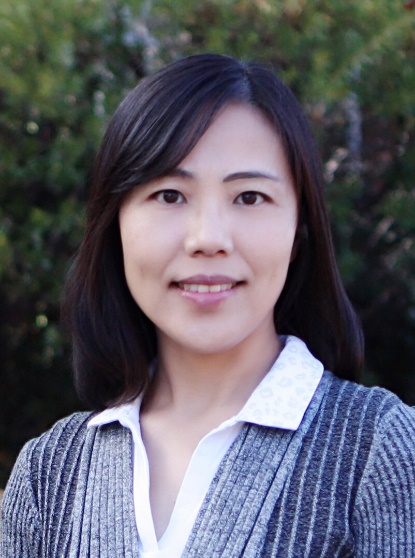Sun Lei
 Lei Sun, Ph.D.
Lei Sun, Ph.D.
B.S. 2001, Tsinghua University, China
Ph.D. 2006, Institute of Biophysics, Chinese Academy of Science
Postdoc, 2006-2008, Wageningen University, the Netherlands
Assistant Research Scientist, 2010-2016, Purdue University, USA
Assistant Professor, Research Track, 2016-2017, UT Southwestern Medical Center, USA
Principal Investigator, 2017-, Fudan University, China
Institutes of Biomedical Sciences, Fudan University, Shanghai 200032 Tel: +86 13651990682
Email: LLSun@fudan.edu.cn
Lab homepage:
Following the undergraduate training at Tsinghua University from 1997 to 2001, Lei Sun joined Dr. Zihe Rao’s lab at Institute of Biophysics, Chinese Academy of Science to pursue the Ph.D. degree in the field of structural biology. After graduation in 2006, Dr. Sun went to Wageningen University, the Netherlands for the postdoc training. She then moved to Purdue university, USA in 2010, and worked as an assistant research scientist with Dr. Michael Rossmann until 2016. From 2016 to 2017, She worked at UT Southwestern Medical Center as a research assistant professor. Since 2017, Dr. Sun joined the Institutes of Biomedical Sciences at Fudan University as a Principal Investigator.
Dr. Sun’s group study the three-dimensional structures of virus, virus proteins and proteins involved in the immune system using interdisciplinary techniques including cryo-EM, X-ray crystallography, biochemistry and computational approaches. Single particle cryo-EM is mostly used to obtain high resolution structure of large protein complexes and viruses.
Major interests: 1) Structural study of human/animal disease-related virus, such as Zika virus, SARS-CoV-2, etc. 2) Viral entry mechanism of bacterial virus.
The research aims to combine structural and functional studies to reveal the virus and protein structure, understand the virus assembly/infection mechanism, and guide the development of antiviral vaccines and drugs.
Wang, Y.; Zhang, X.; Wang, Y.; Ma, Y.; Zhan, W.; Liu, J.; Zhang, M.; Liu, M.; Wang, Q.; Liu, Q.; Sun, T.; Zhu, T.; Wen, Y.; Sun, L.*; Zhao, J.*; Wu, F.*; Chen, Z.*; Huang, J.*, Combating the SARS-CoV-2 Omicron (BA.1) and BA.2 with potent bispecific antibodies engineered from non-Omicron neutralizing antibodies. Cell Discovery 2022
Zhan, W.; Tian, X.; Zhang, X.; Xing, S.; Song, W.; Liu, Q.; Hao, A.; Hu,Y., Zhang, M.; Ying, T.*;Chen, Z.*; Lan, F.*; Sun, L.*, Structural study of SARS-CoV-2 antibodies identifies a broad-spectrum antibody that neutralizes Omicron variant by disassembling the spike trimer. J Virol 2022, 96(16):e0048022. doi10.1128/jvi.00480-22
Li, C.; Zhan, W.; Yang, Z.; Tu, C.; Hu, G.; Zhang, X.; Song, W.; Du, S.; Zhu, Y.; Huang, K.; Kong, Y.; Zhang, M.; Mao, Q.; Gu, X.; Zhang, Y.; Xie, Y.; Deng, Q.; Song, Y.; Chen, Z.; Lu, L.; Jiang, S.; Wu, Y.*; Sun, L.*; Ying, T.*, Broad neutralization of SARS-CoV-2 variants by an inhalable bispecific single-domain antibody. Cell 2022,185 (8), 1389-1401 e18.
Wang, Y.; Zhan, W.; Liu J.; Wang, Y.; Zhang, X.; Zhang, M.; Han, L.; Ma, Y.; Lu, L.; Wen, Y.; Chen, Z.; Zhao, J. *; Wu, F. *; Sun, L. * and Huang, J. *, A broadly neutralizing antibody against SARS-CoV-2 Omicron variant infection exhibiting a novel trimer dimer conformation in spike protein binding. Cell Research 2022,32,862-865
Liu, Z.; Xu, W.; Chen, Z.; Fu, W.; Zhan, W.; Gao, Y.; Zhou, J.; Zhou, Y.; Wu, J.; Wang, Q.; Zhang, X.; Hao, A.; Wu, W.; Zhang, Q.; Li, Y.; Fan, K.; Chen, R.; Jiang, Q.; Mayer, C. T.; Schoofs, T.; Xie, Y.; Jiang, S.; Wen, Y.; Yuan, Z.*; Wang, K.*; Lu, L.*; Sun, L.*; Wang, Q.*, An ultrapotent pan-beta-coronavirus lineage B (beta-CoV-B) neutralizing antibody locks the receptor-binding domain in closed conformation by targeting its conserved epitope. Protein&Cell 2022, 13(9): 655–675.
Zhao, Y.; Du, X.; Duan, Y.; Pan, X.; Sun, Y.; You, T.; Han, L.; Jin, Z.; Shang, W.; Yu, J.; Guo, H.; Liu, Q.; Wu, Y.; Peng, C.; Wang, J.; Zhu, C.; Yang, X.; Yang, K.; Lei, Y.; Guddat, L. W.; Xu, W.; Xiao, G.; Sun, L.*; Zhang, L.*; Rao, Z.*; Yang, H.*, High-throughput screening identifies established drugs as SARS-CoV-2 PLpro inhibitors. Protein&Cell 2021,12 (11), 877-888.
Yue, T.; Zhan, X.; Zhang, D.; Jain, R.; Wang, K. W.; Choi, J. H.; Misawa, T.; Su, L.; Quan, J.; Hildebrand, S.; Xu, D.; Li, X.; Turer, E.; Sun, L.; Moresco, E. M. Y.; Beutler, B.*, SLFN2 protection of tRNAs from stress-induced cleavage is essential for T cell-mediated immunity. Science 2021,372 (6543).
Hu, Y.; Sun, L.*, Systematic Analysis of Structure Similarity between Zika Virus and Other Flaviviruses. ACS Infect Dis 2019,5 (7), 1070-1080.
Chen, Z.#; Sun, L.#; Zhang, Z.#; Fokine, A.; Padilla-Sanchez, V.; Hanein, D.; Jiang, W.; Rossmann, M. G.*; Rao, V. B.*, Cryo-EM structure of the bacteriophage T4 isometric head at 3.3-A resolution and its relevance to the assembly of icosahedral viruses. Proc Natl Acad Sci U S A 2017,114 (39), E8184-E8193.
Sun, L.#; Zhang, X.#; Gao, S.#; Rao, P. A.; Padilla-Sanchez, V.; Chen, Z.; Sun, S.; Xiang, Y.; Subramaniam, S.; Rao, V. B.*; Rossmann, M. G.*, Cryo-EM structure of the bacteriophage T4 portal protein assembly at near-atomic resolution. Nat Commun 2015,6, 7548.
Sun, L.; Young, L. N.; Zhang, X.; Boudko, S. P.; Fokine, A.; Zbornik, E.; Roznowski, A. P.; Molineux, I. J.; Rossmann, M. G.*; Fane, B. A.*, Icosahedral bacteriophage PhiX174 forms a tail for DNA transport during infection. Nature 2014,505 (7483), 432-5.
Sun, L.; Rossmann, M. G.*; Fane, B. A.*, High-resolution structure of a virally encoded DNA-translocating conduit and the mechanism of DNA penetration. J Virol 2014,88 (18), 10276-9.